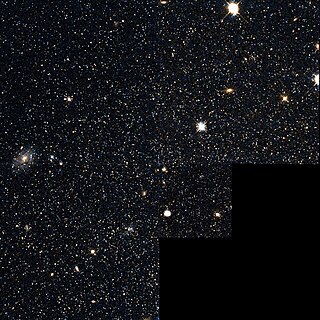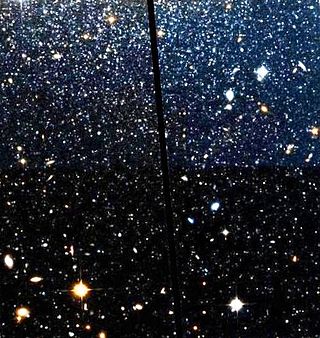
The Local Group is the galaxy group that includes the Milky Way, where Earth is located. It has a total diameter of roughly 3 megaparsecs (10 million light-years; 9×1019 kilometres), and a total mass of the order of 2×1012 solar masses (4×1042 kg). It consists of two collections of galaxies in a "dumbbell" shape; the Milky Way and its satellites form one lobe, and the Andromeda Galaxy and its satellites constitute the other. The two collections are separated by about 800 kiloparsecs (3×10^6 ly; 2×1019 km) and are moving toward one another with a velocity of 123 km/s. The group itself is a part of the larger Virgo Supercluster, which may be a part of the Laniakea Supercluster. The exact number of galaxies in the Local Group is unknown as some are occluded by the Milky Way; however, at least 80 members are known, most of which are dwarf galaxies.

The Andromeda Galaxy is a barred spiral galaxy and is the nearest major galaxy to the Milky Way. It was originally named the Andromeda Nebula and is cataloged as Messier 31, M31, and NGC 224. Andromeda has a D25 isophotal diameter of about 46.56 kiloparsecs (152,000 light-years) and is approximately 765 kpc (2.5 million light-years) from Earth. The galaxy's name stems from the area of Earth's sky in which it appears, the constellation of Andromeda, which itself is named after the princess who was the wife of Perseus in Greek mythology.

The Pegasus Dwarf Spheroidal is a dwarf spheroidal galaxy about 2.7 million light-years away in the constellation Pegasus. The Pegasus Dwarf is a member of the Local Group and a satellite galaxy of the Andromeda Galaxy (M31).

The Pegasus Dwarf Irregular Galaxy is a dwarf irregular galaxy in the direction of the constellation Pegasus. It was discovered by A. G. Wilson in the 1950s. The Pegasus Dwarf is a companion of the Andromeda Galaxy in the Local Group.

Andromeda I is a dwarf spheroidal galaxy (dSph) about 2.40 million light-years away in the constellation Andromeda. Andromeda I is part of the local group of galaxies and a satellite galaxy of the Andromeda Galaxy (M31). It is roughly 3.5 degrees south and slightly east of M31. As of 2005, it is the closest known dSph companion to M31 at an estimated projected distance of ~40 kpc or ~150,000 light-years.

The Tucana Dwarf Galaxy is a dwarf galaxy in the constellation Tucana. It was discovered in 1990 by R.J. Lavery of Mount Stromlo Observatory. It is composed of very old stars and is very isolated from other galaxies. Its location on the opposite side of the Milky Way from other Local Group galaxies makes it an important object for study.

The Pisces Dwarf, also known as Pisces I, is an irregular dwarf galaxy that is part of the Local Group. The galaxy, taking its name from the constellation Pisces where it appears, is suspected of being a satellite galaxy of the Triangulum Galaxy (M33). It displays a blueshift, as it is approaching the Milky Way at 287 km/s. It may be transition-type galaxy, somewhere between dwarf spheroidal and dwarf irregular. Alternatively, it may be a rare, but statistically acceptable, version of one of the two types.
Andromeda IX is a dwarf spheroidal satellite of the Andromeda Galaxy. It was discovered in 2004 by resolved stellar photometry from the Sloan Digital Sky Survey (SDSS), by Zucker et al. (2004). At the time of its discovery, it was the galaxy with the lowest known surface brightness, ΣV ≃ 26.8mags arcsec−2 and the faintest galaxy known from its intrinsic absolute brightness.

Andromeda II is a dwarf spheroidal galaxy about 2.22 Mly away in the constellation Pisces. While part of the Local Group, it is not quite clear if it is a satellite of the Andromeda Galaxy or the Triangulum Galaxy.
Andromeda III is a dwarf spheroidal galaxy about 2.44 million light-years away in the constellation Andromeda. It is part of the Local Group and is a satellite galaxy of the Andromeda Galaxy (M31). The galaxy was discovered by Sidney van den Bergh on photographic plates taken in 1970 and 1971.

Andromeda IV is an isolated irregular dwarf galaxy. The moderate surface brightness, a very blue color, low current star formation rate and low metallicity are consistent with it being a small (background) dwarf irregular galaxy, perhaps similar to Local Group dwarfs such as IC 1613 and Sextans A. Arguments based on the observed radial velocity and the tentative detection of the RGB tip suggest that it lies well outside the confines of the Local Group.
Andromeda V is a dwarf spheroidal galaxy about 2.52 Mly away in the constellation Andromeda.

Cetus Dwarf is a dwarf spheroidal galaxy. It lies approximately 2.46 Million light-years from Earth. It is an isolated galaxy of the Local Group, which also contains the Milky Way. All of the most readily observable stars in the galaxy are red giants.
Pisces II is a dwarf spheroidal galaxy situated in the Pisces constellation and discovered in 2010 in the data obtained by the Sloan Digital Sky Survey. The galaxy is located at the distance of about 180 kpc (kiloparsecs) from the Sun. It is classified as a dwarf spheroidal galaxy (dSph) meaning that it has an elongated shape with the half-light radius of about 60 pc and ratio of the axis of about 5:3.
Andromeda XXI is a moderately bright dwarf spheroidal galaxy about 859 ± 51 kiloparsecs (2.80 ± 0.17 Mly) away from the Sun in the constellation Andromeda. It is the fourth largest Local Group dwarf spheroidal galaxy. The discovery arose from the first year data of a photometric survey of the M31/M33 subgroupings of the Local Group by the Pan-Andromeda Archaeological Survey (PAndAS). This survey was conducted with the Megaprime/MegaCam wide-field camera mounted on the Canada-France-Hawaii Telescope.
Andromeda XXII is a low surface brightness dwarf spheroidal galaxy about 940–1,033 kiloparsecs away from the Sun in the constellation Pisces, of the Local Group.
Andromeda XIX is a satellite galaxy of the Andromeda Galaxy (M31), a member of the Local Group, like the Milky Way Galaxy. Andromeda XIX is considered "the most extended dwarf galaxy known in the Local Group", and has been shown to have a half-light radius of 1.7 kiloparsec (kpc). It was discovered by the Canada–France–Hawaii Telescope, and is thought to be a dwarf galaxy.











